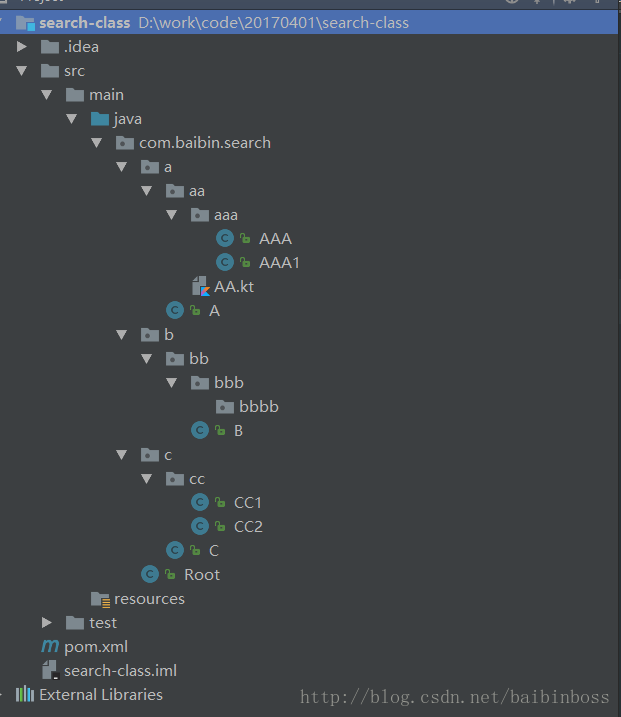本篇文章给大家分享的是有关使用java怎么扫描指定包下的类,小编觉得挺实用的,因此分享给大家学习,希望大家阅读完这篇文章后可以有所收获,话不多说,跟着小编一起来看看吧。
Java主要应用于:1. web开发;2. Android开发;3. 客户端开发;4. 网页开发;5. 企业级应用开发;6. Java大数据开发;7.游戏开发等。
首先,比较简单的是得到我们自己写的类,我们先来完成这个,
项目的结构图如下:

我故意创建了这么个比较复杂的项目结构,现在我们就来获取com.baibin包下所有的类,并且打印他们,代码如下:
import org.junit.Test;
import java.io.File;
import java.util.ArrayList;
import java.util.List;
public class Main {
List<String> classPaths = new ArrayList<String>();
@Test
public void searchClass() throws ClassNotFoundException {
//包名
String basePack = "com.baibin";
//先把包名转换为路径,首先得到项目的classpath
String classpath = Main.class.getResource("/").getPath();
//然后把我们的包名basPach转换为路径名
basePack = basePack.replace(".", File.separator);
//然后把classpath和basePack合并
String searchPath = classpath + basePack;
doPath(new File(searchPath));
//这个时候我们已经得到了指定包下所有的类的绝对路径了。我们现在利用这些绝对路径和java的反射机制得到他们的类对象
for (String s : classPaths) {
//把 D:\work\code\20170401\search-class\target\classes\com\baibin\search\a\A.class 这样的绝对路径转换为全类名com.baibin.search.a.A
s = s.replace(classpath.replace("/","\\").replaceFirst("\\\\",""),"").replace("\\",".").replace(".class","");
Class cls = Class.forName(s);
System.out.println(cls);
}
}
/**
* 该方法会得到所有的类,将类的绝对路径写入到classPaths中
* @param file
*/
private void doPath(File file) {
if (file.isDirectory()) {//文件夹
//文件夹我们就递归
File[] files = file.listFiles();
for (File f1 : files) {
doPath(f1);
}
} else {//标准文件
//标准文件我们就判断是否是class文件
if (file.getName().endsWith(".class")) {
//如果是class文件我们就放入我们的集合中。
classPaths.add(file.getPath());
}
}
}
}效果如下:

总结:这样的src下面的都比较容易处理,也很容易想到,但是jar包下面的就没这么简单了,
但是还是有办法的。
jar下的类我们可以通过JarURLConnection类来或者,代码如下:
import org.junit.Test;
import java.io.IOException;
import java.net.JarURLConnection;
import java.net.URL;
import java.util.Enumeration;
import java.util.jar.JarEntry;
import java.util.jar.JarFile;
public class JarMain {
@Test
public void searchClass() throws IOException, ClassNotFoundException {
String basePack = "org.junit";
//通过当前线程得到类加载器从而得到URL的枚举
Enumeration<URL> urlEnumeration = Thread.currentThread().getContextClassLoader().getResources(basePack.replace(".", "/"));
while (urlEnumeration.hasMoreElements()) {
URL url = urlEnumeration.nextElement();//得到的结果大概是:jar:file:/C:/Users/ibm/.m2/repository/junit/junit/4.12/junit-4.12.jar!/org/junit
String protocol = url.getProtocol();//大概是jar
if ("jar".equalsIgnoreCase(protocol)) {
//转换为JarURLConnection
JarURLConnection connection = (JarURLConnection) url.openConnection();
if (connection != null) {
JarFile jarFile = connection.getJarFile();
if (jarFile != null) {
//得到该jar文件下面的类实体
Enumeration<JarEntry> jarEntryEnumeration = jarFile.entries();
while (jarEntryEnumeration.hasMoreElements()) {
/*entry的结果大概是这样:
org/
org/junit/
org/junit/rules/
org/junit/runners/*/
JarEntry entry = jarEntryEnumeration.nextElement();
String jarEntryName = entry.getName();
//这里我们需要过滤不是class文件和不在basePack包名下的类
if (jarEntryName.contains(".class") && jarEntryName.replaceAll("/",".").startsWith(basePack)) {
String className = jarEntryName.substring(0, jarEntryName.lastIndexOf(".")).replace("/", ".");
Class cls = Class.forName(className);
System.out.println(cls);
}
}
}
}
}
}
}
}通过这两种方式我们就可以得到指定包名下面所有的类了,这个还是挺有用的,
比如spring中经常用来扫描指定包注解的实现等。
补充:获取指定包名下的所有类
写了一个工具类,用于获取指定包名下的所有类,支持递归遍历,支持注解过滤,可从 classpath (class 文件与 jar 包)中获取。
import java.io.File;
import java.io.FileFilter;
import java.lang.annotation.Annotation;
import java.net.JarURLConnection;
import java.net.URL;
import java.util.ArrayList;
import java.util.Enumeration;
import java.util.List;
import java.util.jar.JarEntry;
import java.util.jar.JarFile;
public class ClassUtil {
// 获取指定包名下的所有类
public static List<Class<?>> getClassList(String packageName, boolean isRecursive) {
List<Class<?>> classList = new ArrayList<Class<?>>();
try {
Enumeration<URL> urls = Thread.currentThread().getContextClassLoader().getResources(packageName.replaceAll("\\.", "/"));
while (urls.hasMoreElements()) {
URL url = urls.nextElement();
if (url != null) {
String protocol = url.getProtocol();
if (protocol.equals("file")) {
String packagePath = url.getPath();
addClass(classList, packagePath, packageName, isRecursive);
} else if (protocol.equals("jar")) {
JarURLConnection jarURLConnection = (JarURLConnection) url.openConnection();
JarFile jarFile = jarURLConnection.getJarFile();
Enumeration<JarEntry> jarEntries = jarFile.entries();
while (jarEntries.hasMoreElements()) {
JarEntry jarEntry = jarEntries.nextElement();
String jarEntryName = jarEntry.getName();
if (jarEntryName.endsWith(".class")) {
String className = jarEntryName.substring(0, jarEntryName.lastIndexOf(".")).replaceAll("/", ".");
if (isRecursive || className.substring(0, className.lastIndexOf(".")).equals(packageName)) {
classList.add(Class.forName(className));
}
}
}
}
}
}
} catch (Exception e) {
e.printStackTrace();
}
return classList;
}
// 获取指定包名下的所有类(可根据注解进行过滤)
public static List<Class<?>> getClassListByAnnotation(String packageName, Class<? extends Annotation> annotationClass) {
List<Class<?>> classList = new ArrayList<Class<?>>();
try {
Enumeration<URL> urls = Thread.currentThread().getContextClassLoader().getResources(packageName.replaceAll("\\.", "/"));
while (urls.hasMoreElements()) {
URL url = urls.nextElement();
if (url != null) {
String protocol = url.getProtocol();
if (protocol.equals("file")) {
String packagePath = url.getPath();
addClassByAnnotation(classList, packagePath, packageName, annotationClass);
} else if (protocol.equals("jar")) {
JarURLConnection jarURLConnection = (JarURLConnection) url.openConnection();
JarFile jarFile = jarURLConnection.getJarFile();
Enumeration<JarEntry> jarEntries = jarFile.entries();
while (jarEntries.hasMoreElements()) {
JarEntry jarEntry = jarEntries.nextElement();
String jarEntryName = jarEntry.getName();
if (jarEntryName.endsWith(".class")) {
String className = jarEntryName.substring(0, jarEntryName.lastIndexOf(".")).replaceAll("/", ".");
Class<?> cls = Class.forName(className);
if (cls.isAnnotationPresent(annotationClass)) {
classList.add(cls);
}
}
}
}
}
}
} catch (Exception e) {
e.printStackTrace();
}
return classList;
}
private static void addClass(List<Class<?>> classList, String packagePath, String packageName, boolean isRecursive) {
try {
File[] files = getClassFiles(packagePath);
if (files != null) {
for (File file : files) {
String fileName = file.getName();
if (file.isFile()) {
String className = getClassName(packageName, fileName);
classList.add(Class.forName(className));
} else {
if (isRecursive) {
String subPackagePath = getSubPackagePath(packagePath, fileName);
String subPackageName = getSubPackageName(packageName, fileName);
addClass(classList, subPackagePath, subPackageName, isRecursive);
}
}
}
}
} catch (Exception e) {
e.printStackTrace();
}
}
private static File[] getClassFiles(String packagePath) {
return new File(packagePath).listFiles(new FileFilter() {
@Override
public boolean accept(File file) {
return (file.isFile() && file.getName().endsWith(".class")) || file.isDirectory();
}
});
}
private static String getClassName(String packageName, String fileName) {
String className = fileName.substring(0, fileName.lastIndexOf("."));
if (StringUtil.isNotEmpty(packageName)) {
className = packageName + "." + className;
}
return className;
}
private static String getSubPackagePath(String packagePath, String filePath) {
String subPackagePath = filePath;
if (StringUtil.isNotEmpty(packagePath)) {
subPackagePath = packagePath + "/" + subPackagePath;
}
return subPackagePath;
}
private static String getSubPackageName(String packageName, String filePath) {
String subPackageName = filePath;
if (StringUtil.isNotEmpty(packageName)) {
subPackageName = packageName + "." + subPackageName;
}
return subPackageName;
}
private static void addClassByAnnotation(List<Class<?>> classList, String packagePath, String packageName, Class<? extends Annotation> annotationClass) {
try {
File[] files = getClassFiles(packagePath);
if (files != null) {
for (File file : files) {
String fileName = file.getName();
if (file.isFile()) {
String className = getClassName(packageName, fileName);
Class<?> cls = Class.forName(className);
if (cls.isAnnotationPresent(annotationClass)) {
classList.add(cls);
}
} else {
String subPackagePath = getSubPackagePath(packagePath, fileName);
String subPackageName = getSubPackageName(packageName, fileName);
addClassByAnnotation(classList, subPackagePath, subPackageName, annotationClass);
}
}
}
} catch (Exception e) {
e.printStackTrace();
}
}
}以上就是使用java怎么扫描指定包下的类,小编相信有部分知识点可能是我们日常工作会见到或用到的。希望你能通过这篇文章学到更多知识。更多详情敬请关注亿速云行业资讯频道。
亿速云「云服务器」,即开即用、新一代英特尔至强铂金CPU、三副本存储NVMe SSD云盘,价格低至29元/月。点击查看>>
免责声明:本站发布的内容(图片、视频和文字)以原创、转载和分享为主,文章观点不代表本网站立场,如果涉及侵权请联系站长邮箱:is@yisu.com进行举报,并提供相关证据,一经查实,将立刻删除涉嫌侵权内容。